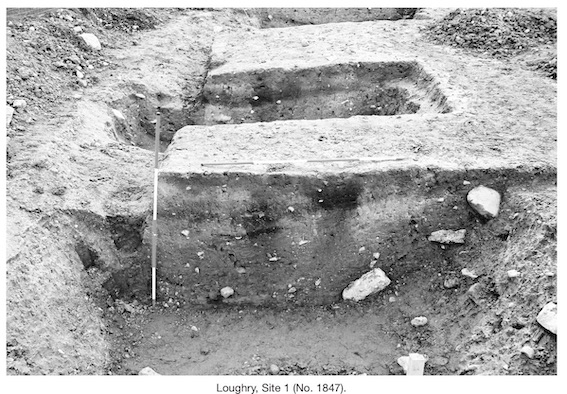County: Tyrone Site name: LOUGHRY AND ROCKHEAD
Sites and Monuments Record No.: N/A Licence number: AE/03/68
Author: Robert M. Chapple, for Northern Archaeological Consultancy Ltd.
Site type: Enclosure and House - Bronze Age
Period/Dating: Bronze Age (2200 BC-801 BC)
ITM: E 681374m, N 875066m
Latitude, Longitude (decimal degrees): 54.617271, -6.740114
Monitored topsoil re-scraping and spoilheap investigation took place during June 2003 at a development site in Loughry, Cookstown, prior to the construction of playing fields and ancillary buildings as part of the 'Mid Ulster Sports Complex' by Cookstown District Council. The area lay within the grounds of Loughry College of Agriculture & Food Technology, c. 1.7km to the south of Cookstown, on the eastern side of the main road from Cookstown to Dungannon. The site consisted of two drumlins, with an area of lower ground between. Excavation took place between 25 June and 12 September 2003. A total of eighteen areas of potential archaeological significance were investigated. The majority of these were either found to be of natural origin or were isolated pits with little or no evidence for dating. However, one site each was discovered on the tops of the two drumlins.
Site 1 lay on the more southerly of the two drumlins and appears to have been a roughly circular enclosure, c. 43m in internal diameter, bounded by a ditch averaging 4.28m wide by 1.3m deep. Three trenches were opened across this ditch in its eastern quadrant. The basal fill appeared to have derived from redeposited natural subsoil, making the location of the exact lines of the ditch cut difficult to ascertain. Above this was a relatively thin (c. 0.5m) layer of soft, dark-brownish to greyish-black clayey silt (F101), which produced 856 sherds of pottery, of which 654 bore decoration. Although no formal analysis has yet taken place, it appears that this assemblage represents multiple forms of simple, bipartite and tripartite bowl vessels, along with various forms of urn of Early Bronze Age date. It was obvious from the sherd dispersal patterns that these vessels were broken and smashed within the ditch, presumably mixing their respective contents in the process. The same layer also produced 1129 pieces of worked flint. Various blades, flakes, cores and multiple pieces of micro-debitage are represented. Of the completed artefacts, 94 scrapers of various forms were recovered, along with five flint knives and five arrowheads (one of which is a finely made hollow-based example). Seven possible hammerstones were also recorded. Finally, some 196 pieces of bone were recovered from F101. Although not yet analysed, one piece may be tentatively identified as the enamel of a pig tooth. The entire ditch was covered by a layer of redeposited natural, possibly deriving from a dissipated internal mound or bank. However, no investigation of any potential internal features was carried out. Once the scale of the site was realised, agreement was reached between the developer and the Environment & Heritage Service to preserve it in situ and, once the investigation of the initial trenches was complete, the site was covered in geotextile and backfilled.
Site 16 lay on the more northerly of the two drumlins. Similar to the situation with Site 1, the developer agreed to alter the planned development to allow preservation in situ. During the initial investigation phase, this site appeared as a pair of segmented, concentric circles with a maximum diameter of 11.34m. Two trenches were placed across the site, revealing that the innermost circle (8.12m in maximum diameter) appeared to have been a wall-slot with occasional post-holes inserted through it, with the outer ring acting as a drip-trench. Near the centre of the structure a series of six stake-holes was recorded, though no discernible pattern was visible. Also, the absence of a hearth may indicate that considerable truncation has occurred over the site. Seven sherds of undecorated Bronze Age pottery were recovered from the site, though none are decorated. In total, 39 pieces of worked flint were produced, including various blade and flake forms, along with cores and micro-debitage. However, in the absence of professional analysis, only two pieces are tentatively identified as scrapers.

19 Irwin Drive, Belfast BT4 3AR